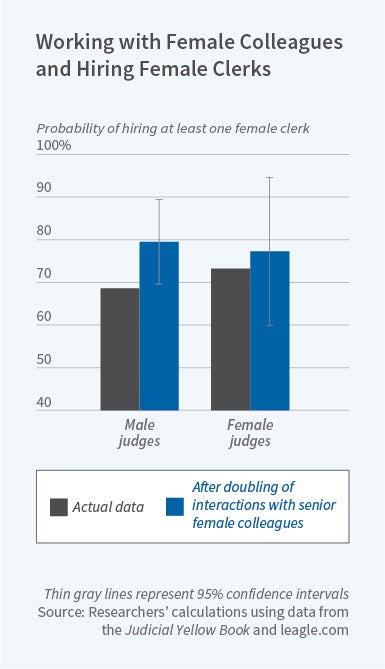After Working with Female Peers, Federal Judges Hire More Women
Male judges who hear more cases alongside female judges are 4.3 percentage points more likely to hire a female law clerk subsequently.
Labor-market discrimination can be harmful to those who are discriminated against as well as to society at large, since discrimination can lead to inefficient allocation of workers to potential jobs. There is an active debate over the extent of such discrimination, and how to address it.
In Professional Interactions and Hiring Decisions: Evidence from the Federal Judiciary (NBER Working Paper 26726), Marco Battaglini, Jorgen M. Harris, and Eleonora Patacchini study how one oft-discussed remedy for labor market discrimination — increased professional exposure to members of an out-group, in this case women — affects hiring practices.
US appellate court judges are randomly assigned to hear cases, typically alongside two colleagues who also are randomly assigned. As a result, the number of female colleagues with whom a given judge will hear cases is essentially random. The researchers use this source of variation to analyze how increased exposure to female colleagues affects judges’ future decisions in the hiring of law clerks. Clerks’ jobs are prestigious positions typically filled by graduates of top law schools. Judges enjoy almost complete control over the hiring of their law clerks.
The researchers hypothesize that judges may increase their hiring of female law clerks after working with female judicial colleagues because they have a more positive view of women’s professional capabilities. Using data from the Judicial Yellow Book and a database of federal court cases, the researchers find that judges who hear more cases alongside female colleagues are 4 percentage points more likely to hire at least one female law clerk in the following year. They also examine whether exposure differentially affects judges who vary in meaningful ways — by gender, age, experience level, political affiliation, status, quality, and current law clerk staff composition. The effects of exposure to female judicial colleagues are larger for men, for judges whose current roster of law clerks is majority male, and for less-experienced judges. For example, male judges who hear more cases alongside female judges are 4.3 percentage points more likely to hire a female law clerk subsequently, while female judges who hear more cases alongside female judges are 1.6 percentage points more likely to hire a female law clerk subsequently.
The researchers note that most of the judges in the sample are older and began their careers when women were less prevalent in the legal profession. “Federal judges make hiring decisions in a labor market where women are significantly more numerous and successful than they were when the judges first entered the legal profession and the judiciary,” they write.
The researchers note that their findings have important implications for the labor market and for companies seeking to diversify their ranks. “[I]ncreases in the diversity of the upper rungs of a profession can shift attitudes in a way that creates opportunities at the entry level of the profession,” they conclude. “[I]ncreasing the diversity in the leadership of a profession… may have benefits beyond their immediate beneficiaries.”
— Dwyer Gunn



